

Advisory Committee to Economics Ministry in Favour of Capacity Market in the Long-term « German Energy Blog. The Scientific Advisory Committee to the Federal Ministry of Economics and Technology (BMWi) submitted a report on the long-term management of the security of supply, in which it highlights the current positive situation, but recommends to introduce a capacity market to provide sufficient flexible power in the long-run.
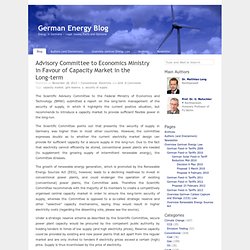
The Scientific Committee points out that presently the security of supply in Germany was higher than in most other countries. However, the committee expresses doubts as to whether the current electricity market design can provide for sufficient capacity for a secure supply in the long-run. Due to the fact that electricity cannot efficiently be stored, conventional power plants are needed (to supplement the growing supply of intermittent renewable energy), the Committee stresses. A secure electricity supply was of fundamental importance for Germany’s economic performance and competitiveness, BMWi said, welcoming that the Scientific Committee highlighted this aspect.
Prix négatifs de l'électricité - Negative electricity prices. CCGT in European electricity market post 2010. PJM Market: Good, Can Get Better by EU Energy Policy Blog. The PJM market has always been, and continues to be, a source of fascination to anyone interested in organized or competitive wholesale electricity markets.
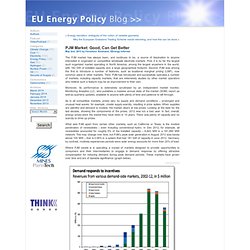
First, it is by far the largest such organized market operating in North America, among the largest anywhere in the world, with 182 GW of installed capacity and a large geographical footprint. Second, PJM was among the first to introduce a number of features, such as locational marginal pricing (LMP), now common place in other markets. Third, PJM has introduced and successfully operates a number of markets, including capacity markets, that are extensively studies by other market operators who believe such a feature may be an improvement to their own. Moreover, its performance is extensively scrutinized by an independent market monitor, Monitoring Analytics LLC, who publishes a massive annual state of the market (SOM) report as well as quarterly updates, available to anyone with plenty of time and patience to sift through.
Untitled. Electricity Markets. Global Market Analysis/Forecasts. Wp1205_EuropeanElectricityAndInterrelatedFuturesMarketsACointegratedVectorAutoregressiveAnalysis.pdf (Objet application/pdf) Analyse-sectorielle-enjeux-deregulation-marche-electricite.pdf (Objet application/pdf) Renewable_Power_Generation_Costs.pdf (Objet application/pdf) 20121115_iem_swd_0368_part2_en.pdf (Objet application/pdf) Le marché de l'énergie français, l'un des plus "concentré d'Europe", selon Bruxelles.
Déplacer sans enlever : l’angle mort du marché unique européen. Annexe_7.pdf (Objet application/pdf) Dynamic Electricity Pricing. For most things people purchase – like toothpaste, books, and televisions – prices don’t change over the course of the day: Consumers pay the same price regardless of whether they buy it at 8am, 2pm or 10pm.
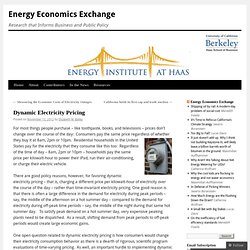
Residential households in the United States pay for the electricity that they consume like this too: Regardless of the time of day – 8am, 2pm or 10pm – households pay the same price per kilowatt-hour to power their iPad, run their air-conditioning, or charge their electric vehicle. There are good policy reasons, however, for favoring dynamic electricity pricing – that is, charging a different price per kilowatt-hour of electricity over the course of the day – rather than time-invariant electricity pricing. One open question related to dynamic electricity pricing is how consumers would change their electricity consumption behavior as there is a dearth of rigorous, scientific program evaluations of time-varying pricing. Like this: Colloque FNCCR-Amorce: les poouèrepoïntes. Bienvenue sur le site officiel du CLEEE. Dp_2011_cordemais.pdf (Objet application/pdf) C11_NR_France-LL.pdf (Objet application/pdf) De quoi est fait le prix final de l'électricité - Sea Conseil Janvier 212.
nW_Pointe_elec_Dossier_de_presse_011209.pdf (Objet application/pdf) Levy-bernhart.pdf (Objet application/pdf) Stochastic programming in Energy : Theory vs Practical Application (Verbund) German power exports to France increasing - 100% renewable. Switch to renewables The current cold spell in Europe is having an effect on international power exports.
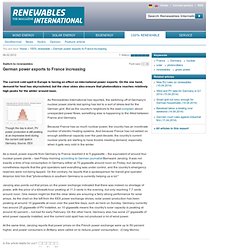
On the one hand, demand for heat has skyrocketed, but the clear skies also ensure that photovoltaics reaches relatively high peaks for the winter around noon. As Renewables International has reported, the switching off of Germany's nuclear power plants last spring has led to a sort of stress test for the German grid. But as the country's neighbors to the east complain about unexpected power flows, something else is happening to the West between France and Germany.
Because France has so much nuclear power, the country has an inordinate number of electric heating systems. As a result, power exports from Germany to France reached 4 to 5 gigawatts – the equivalent of around four nuclear power plants – last Friday morning according to German journalist Bernward Janzing.
German FIT surcharge could explode - 100% renewable. Cost of renewable power According to a report in German economics daily Handelsblatt, the surcharge passed on to our consumers to cover the cost of feed-in tariffs in Germany could rise by nearly 50% this fall.
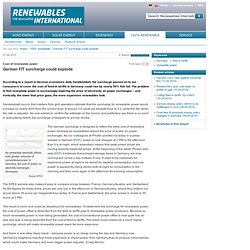
The problem is that renewable power is increasingly lowering the price of electricity on power exchanges – and ironically, the lower that price goes, the more expensive renewables look. Handelsblatt reports that insiders from grid operators estimate that the surcharge for renewable power would increase by nearly 50% from the current level of around 3.6 cents per kilowatt-hour to 5.2 cents this fall, when the rate is adjusted. No one wishes to confirm the estimate on the record, and politicians say there is no point in speculating before the surcharge undergoes its annual review. The German surcharge is designed to reflect the extra cost of renewable power increase as renewables reduce the price of power on power exchanges.
Le coût de l'énergie éolienne - Prix de rachat. Hauteur de mat, taille du rotor, forme des pales, rendement des alternateurs, meilleur gestion du vent... sont autant d'améliorations qui réduisent les couts de production de l'énergie électrique issue du vent.
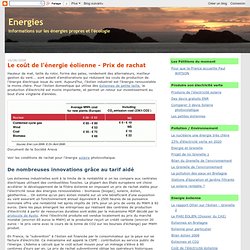
Aujourd'hui, l'éolien industriel est l'énergie renouvelable la moins chère. Pour l'éolien domestique qui utilise des éoliennes de petite taille, la production d'électricité est moins importante, et permet un retour sur investissement au bout d'une vingtaine d'années. Document de la Société Areva Voir les conditions de rachat pour l'énergie solaire photovoltaique.
Augmentation du tarif de l'électricité : l'alibi des énergies renouvelables. Le ministre du Budget, François Baroin, a confirmé mercredi dernier l’augmentation de 3% des tarifs de l’électricité attendue début 2011, qui doit "alléger le fardeau financier pour EDF du rachat de l’énergie solaire".
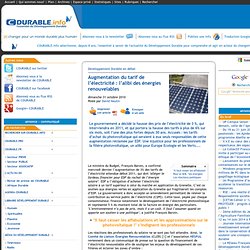
EDF a l’obligation d’acheter l’électricité solaire à un tarif supérieur à celui du marché en application du Grenelle. C’est ce soutien aux énergies vertes en application du Grenelle qui fragiliserait les comptes d’EDF. Le gouvernement a donc accepté un amendement permettant de relever la contribution au service public de l’électricité (CSPE).
Cette taxe, payée par chaque consommateur, finance notamment le développement de l’électricité photovoltaïque et représente 5 % du montant total de la facture en énergie des particuliers. "L’environnement n’a pas de prix, mais il a un coût. 03/23 > BE Japon 610 > Contrer la hausse des tarifs de l'énergie : les propositions du METI. EnergieContrer la hausse des tarifs de l'énergie : les propositions du METI.
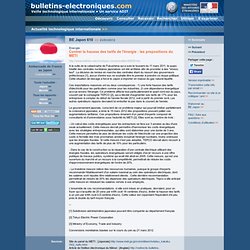
Gde distribution et énergie. Loi Nome. Augmentation des tarifs de l'électricité en france 2010-2020. Nucléaire et Arenh. Mécanisme ajustement, Marché de Capacité et effacement. Marché de l'électricité - Marché de détail - Marchés. Lettre d'information de la Commision de Régulation de l'Énergie, Verbund toucherait le fond sur Sambre.
Marché de l'électricité : EDF fait un geste pour la concurrence. Détail d'un texte. Les tarifs d'utilisation des réseaux de transport, de distribution des installations de gaz naturel liquéfié. La mise en œuvre du deuxième tarif d’utilisation des réseaux publics de distribution Le ministre de l’Économie, des Finances et de l’Industrie et le ministre délégué à l’Industrie ont approuvé, par une décision du 27 décembre 2005, la proposition tarifaire que la Commission de régulation de l’énergie leur avait transmise le 31 octobre 2005.

Ce nouveau tarif est conforme aux règles de tarification décrites dans le décret n° 2005-22 du 11 janvier 2005, en particulier la couverture des charges d’exploitation et de capital. 832 - Rapport de MM. Christian Bataille et Claude Birraux déposé en application de l'article 6 ter de l'ordonnance n° 58-1100 du 17 novembre 1958 relative au fonctionnement des assemblées parlementaires au nom de M. le Président de l'Office parlementai.
Sur la durée de vie des centrales nucléaires et les nouveaux types de réacteurs.
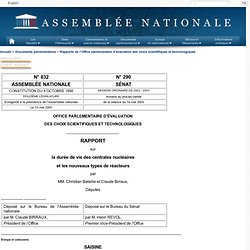
Colloque Gonnot: propos choisis. Schiste Quelques cars de CRS et deux ou trois manifestants brandissant des pancartes - maigrelettes - d'opposition aux gaz de schiste: le colloque "énergie et developpement" du deputé Francois-Michel Gonnot a -encore- gagné en notoriété (parmi les sponsors figure desormais Toreador energy France). "Je ne dis pas qu'il faut developper le gaz de schiste, je dis qu'il faut regarder", a indiqué Jean-Marie Chevalier, professeur à Paris Dauphine.
Le député de l'Oise a rappelé n'avoir pas voté la loi sur l'interdiction de la fracturation hydraulique mais indiqué qu'il la respectait puisqu'elle était votée. > Préalablement, le député de l'Oise avait annoncé que la commission de suivi des techniques d'exploration et d'exploitation des hydrocarbures, prévue par la loi interdisant le recours à la fracturation hydraulique pour exploiter le gaz de schiste, serait bientôt créée. Réseaux de chaleur Franck Lacroix, président de Dalkia, a proposé que soit "multiplié par deux le fonds chaleur".
Transparent Cost Database. Les prix de marchés de gros de l'électricité donnent ils les bons signaux pour l'investissement en capacité de production élec. Why Are Australian Electricity Prices So High? by EU Energy Policy Blog. It is a question that is often asked: Who pays how much for electricity and why? The answer, it turns out, is not as straightforward as it may appear. It may not be as complicated, but is akin to asking what is the most expensive city to live in? Gouvernement espagnol - Augmentation des tarifs de l'élec. A cross country analysis of electricity market reforms.